Next-Generation Airborne Pathogen Detection: Flashing Ratchet Potential in Action
Abstract
1. Introduction
2. Materials and Methods
Flashing Ratchet Potential Design
3. Results
3.1. Transportation of Free Charged Particles
- Without thermionic electrons:
- With thermionic electrons:
3.2. Particle Transport Mechanism in the FRP
- Low voltages (V ≤ 4 V): Many free charges lack sufficient energy to cross the first negative electrode, causing charge accumulation near positive electrodes. Over time, shorter travel paths emerge for some charges, making time-dependent and increasing σ.
- Optimal voltages (5–6 V): Most charges have just enough energy to cross the first electrode d = 1 cm, resulting in smaller σ values and more stable transport.
- High voltages (V > 6 V): Excess energy allows charges to cross the first electrode easily, but also enables boundary escapes. This makes the number of transported charges dependent on time-varying thermionic electron production, increasing σ.
3.3. Detection Methodology Examination
3.4. Sample Preparation and Insertion
- First sample: Extracted from the medium between two filtration stages (150 nm and 50 nm filters), where potential impurities in the viral size range (~100 nm) are most likely to exist.
- Second sample: Extracted from the medium after passing through the 50 nm filter, where the probability of viral particle presence is minimal.
- Case I—Negative test:The subtraction results in a signal fluctuating around zero with no increasing trend over time. This indicates that the two samples are essentially identical, confirming the absence of impurities within the 150–50 nm size range (negative detection).
- Case II—Positive test:The subtraction results in a signal that increases steadily with time, indicating non-identical samples. This confirms the presence of impurity particles within the 150–50 nm range (positive detection). The slope of this ECS line provides a direct measure of impurity density, corresponding to the number of viral particle copies in the sample.
3.5. Enhanced Sample Collection Strategy
- The first sample is directed from the blender through the 150 nm filter directly to the polarization filter, bypassing the 50 nm filter, thereby maximizing the probability of capturing viral particles.
- The second sample is collected only after passing through the 50 nm filter, serving as the “clean” reference sample
4. Discussion and Conclusions
- Proof of Concept: Controlled transport of ions through FRP electrodes is achievable and can be exploited for detecting foreign particles.
- Demonstrated Sensitivity: Impurities as large as talcum powder (26.57 μm) produce clear and quantifiable signatures in the spectrum.
- Scalability: Theoretical models support extension of this methodology to detect viral-scale particles (~100 nm), given appropriate signal processing. In future work, we plan to extend the present theoretical framework by developing a numerical simulation model combining finite-element electric-field mapping and particle-tracking algorithms to visualize the trajectories of superoxide anions and aerosols under varying FRP voltages and frequencies. This modeling effort will complement the current proof-of-concept experiments and provide quantitative insight into ion transport dynamics.
- Improvement Potential: Detection accuracy and sensitivity can be enhanced by refining electrode manufacturing, optimizing FRP operational conditions, and extending measurement duration.
5. Patents
Author Contributions
Funding
Institutional Review Board Statement
Informed Consent Statement
Data Availability Statement
Acknowledgments
Conflicts of Interest
Abbreviations
| FRP | Flashing Ratchet Potential |
| ECS | Electric Current Spectroscopy |
| PCR | Polymerase Chain Reaction |
| RMS | Root Mean Square |
References
- Morawska, A.; Cao, J. Airborne transmission of SARS-CoV-2: The world should face the reality. Environ. Int. 2020, 139, 105730. [Google Scholar] [CrossRef] [PubMed]
- Chang, Y.; Wang, Y.; Li, W.; Wei, Z.; Tang, S.; Chen, R. Mechanisms, techniques and devices of airborne virus detection: A review. Int. J. Environ. Res. Public Health 2023, 20, 5471. [Google Scholar] [CrossRef]
- Peña-Bahamonde, J.; Nguyen, H.N.; Fanourakis, S.K.; Rodrigues, D.F. Recent advances in graphene-based biosensor technology with applications in life sciences. J. Nanobiotechnol. 2018, 16, 75. [Google Scholar] [CrossRef]
- Vidic, J.; Manzano, M. Electrochemical biosensors for rapid pathogen detection. Curr. Opin. Electrochem. 2021, 29, 100750. [Google Scholar] [CrossRef]
- Shanmukh, S.; Jones, L.; Driskell, J.; Zhao, Y.; Dluhy, R.; Tripp, R.A. Rapid and Sensitive Detection of Respiratory Virus Molecular Signatures Using a Silver Nanorod Array SERS Substrate. Nano Lett. 2006, 6, 2630–2636. [Google Scholar] [CrossRef]
- Yang, N.; Li, T.; Dong, S.; Zhang, S.; Jia, Y.; Mao, H.; Zhang, Z.; Zhang, F.; Pan, X.; Zhang, X.; et al. Correction: Detection of airborne pathogens with single photon counting and a real-time spectrometer on microfluidics. Lab Chip 2023, 23, 400. [Google Scholar] [CrossRef]
- Sivakumar, R.; Lee, N.Y. Recent advances in airborne pathogen detection using optical and electrochemical biosensors. Anal. Chim. Acta 2022, 1234, 340297. [Google Scholar] [CrossRef]
- Puthussery, J.V.; Ghumra, D.P.; McBrearty, K.R.; Doherty, B.M.; Sumlin, B.J.; Sarabandi, A.; Mandal, A.G.; Shetty, N.J.; Gardiner, W.D.; Magrecki, J.P.; et al. Real-Time Environmental Surveillance of SARS-CoV-2 Aerosols. Nat. Commun. 2023, 14, 3692. [Google Scholar] [CrossRef] [PubMed]
- Lee, D.; Jang, J.; Jang, J. Sensitive and Highly Rapid Electrochemical Measurement of Airborne Coronaviruses through Condensation-Based Direct Impaction onto Carbon Nanotube-Coated Porous Paper Working Electrodes. J. Hazard. Mater. 2023, 458, 131972. [Google Scholar] [CrossRef]
- Talukder, M.E.; Alam, F.; Pervez, M.N.; Jiangming, W.; Hassan, F.; Stylios, G.K.; Naddeo, V.; Song, H. New Generation Washable PES Membrane Face Mask for Virus Filtration. Nanocomposites 2022, 8, 13–23. [Google Scholar] [CrossRef]
- Wang, Y.; Zhou, Y. Recent progress on anti-humidity strategies of chemiresistive gas sensors. Materials 2022, 15, 8728. [Google Scholar] [CrossRef] [PubMed]
- Albqoor, M.J.A.; Al-Zain, Y.M.Y.; Alkaid Albqoor, M.J.; Isma’il, L.B.J. Airborne Viral Particles and Microorganisms Detection System and Method Using Flashing Ratchet Potential. PCT Patent Application WO2023223369, Published 7 December 2023. Available online: https://patentscope.wipo.int/search/en/detail.jsf?docId=WO2023223369 (accessed on 18 August 2025).
- Bqoor, M.; Al-Zain, Y.; Albqoor, M.A.; Ismail, L. Airborne viral particles and microorganisms detection system and method using flashing ratchet potential. Preprints 2023, 2023091335. [Google Scholar] [CrossRef]
- Reimann, P. Brownian Motors: Noisy Transport Far from Equilibrium. Phys. Rep. 2002, 361, 57–265. [Google Scholar] [CrossRef]
- Skaug, M.J.; Schwemmer, C.; Fringes, S.; Rawlings, C.D.; Knoll, A.W. Nanofluidic rocking Brownian motors. Science 2018, 359, 1505–1508. [Google Scholar] [CrossRef]
- Roche, B.; Roulleau, P.; Jullien, T.; Jompol, Y.; Farrer, I.; Ritchie, D.A.; Glattli, D.C. Harvesting dissipated energy with a mesoscopic ratchet. Nat. Commun. 2015, 6, 6738. [Google Scholar] [CrossRef]
- McCarthy, P.T.; Reifenberger, R.G.; Fisher, T.S. Thermionic and photo-excited electron emission for energy-conversion processes. Front. Energy Res. 2014, 2, 54. [Google Scholar] [CrossRef]
- Ponomarev, A.A.; Aleksandrov, N.L. The kinetics of energetic O− ions in oxygen discharge plasmas. Plasma Sources Sci. Technol. 2017, 26, 044003. [Google Scholar] [CrossRef]
- Vidic, J.; Manzano, M.; Chang, C.-M.; Jaffrezic-Renault, N. Advanced Biosensors for Detection of Pathogens Related to Livestock and Poultry. Vet. Res. 2017, 48, 11. [Google Scholar] [CrossRef]
- Oh, J.; Hart, R.; Capurro, J.; Noh, H.M. Comprehensive analysis of particle motion under non-uniform AC electric fields in a microchannel. Lab Chip 2009, 9, 62–78. [Google Scholar] [CrossRef]
- Mitra, A.; Ignatovich, F.; Novotny, L. Nanofluidic preconcentration and detection of nanoparticles. J. Appl. Phys. 2012, 112, 014306. [Google Scholar] [CrossRef]
- Kulkarni, P.; Baron, P.A.; Willeke, K. (Eds.) Aerosol Measurement: Principles, Techniques, and Applications, 3rd ed.; John Wiley & Sons: Hoboken, NJ, USA, 2011. [Google Scholar]
- Rasmussen, P.E.; Levesque, C.; Niu, J.; Gardner, H.D.; Nilsson, G.; Macey, K. Characterization of airborne particles emitted during application of cosmetic talc products. Int. J. Environ. Res. Public Health 2019, 16, 3830. [Google Scholar] [CrossRef]
- Taniguchi, T.; Kawamura, K.; Sakamoto, S.; Tagashira, H. Three-body attachment in oxygen and an air-like nitrogen and oxygen mixture. J. Phys. D Appl. Phys. 1982, 15, 1187. [Google Scholar] [CrossRef]
- Wachholz Junior, D.; Deroco, P.B.; Hryniewicz, B.M.; Kubota, L.T. Strategies for electrochemical point-of-care biosensors. Annu. Rev. Anal. Chem. 2025, 18, 161–181. [Google Scholar] [CrossRef] [PubMed]
- Jayakumar, A.; Surendranath, A. 2D materials for next generation healthcare applications. Int. J. Pharm. 2018, 551, 309–321. [Google Scholar] [CrossRef]
- Feynman, R.P.; Leighton, R.B.; Sands, M. The Feynman Lectures on Physics, Vol. I; Addison-Wesley: Reading, MA, USA, 1963. [Google Scholar]
- Wang, Z.; Jia, Z.; He, X. Net motion of a charged macromolecule in a ratchet-slit. Soft Matter 2013, 9, 11107–11112. [Google Scholar] [CrossRef]
- Lau, B.; Kedem, O.; Schwabacher, J.; Kwasnieski, D.; Weiss, E.A. An introduction to ratchets in chemistry and biology. Mater. Horiz. 2017, 4, 310–318. [Google Scholar] [CrossRef]
- Lavella, G.; Morfino, R.; Maharbiz, M.M. A synthetic Brownian ratchet architecture for creating tailorable chemomechanical nanomachines. Appl. Phys. Lett. 2012, 101, 013701. [Google Scholar] [CrossRef]
- Pavlyukevich, I.; Li, Y.; Xu, Y.; Chechkin, A. Directed transport induced by spatially modulated Lévy flights. J. Phys. A Math. Theor. 2015, 48, 495004. [Google Scholar] [CrossRef]
- Liao, K.; Collins, S.; Brus, V.; Mikhnenko, O.; Hu, Y.; Phan, H.; Nguyen, T. Electron Ratchets: State of the Field and Future Challenges. ACS Appl. Mater. Interfaces 2019, 11, 1081–1087. [Google Scholar] [CrossRef] [PubMed]
- Bader, J.S.; Hammond, R.W.; Henck, S.A.; Deem, M.W.; McDermott, G.A.; Bustillo, J.M.; Simpson, J.W.; Mulhern, G.T.; Rothberg, J.M. DNA Transport by a Micromachined Brownian Ratchet Device. Proc. Natl. Acad. Sci. USA 1999, 96, 13165–13169. [Google Scholar] [CrossRef] [PubMed]
- Depperschmidt, A.; Ketterer, N.; Pfaffelhuber, P. A Brownian Ratchet for Protein Translocation Including Dissociation of Ratcheting Sites. J. Math. Biol. 2013, 66, 505–534. [Google Scholar] [CrossRef] [PubMed]
- Zarrin, A.; Sivak, D.A.; Brown, A.I. Breaking Time-Reversal Symmetry for Ratchet Models of Molecular Machines. Phys. Rev. E 2019, 99, 062127. [Google Scholar] [CrossRef]
- Chen, Q.; Wu, J.C.; Hu, C.T.; Ou, Y.L.; Ai, B.Q. Transport of Interacting Self-Propelled Brownian Particles in a Common Ratchet Potential. Eur. Phys. J. B 2015, 88, 22. [Google Scholar] [CrossRef]
- Plyukhin, A.V. Intrinsic Ratchets: A Hamiltonian Approach. Phys. Rev. E 2018, 98, 042130. [Google Scholar] [CrossRef]
- Ryabov, A.; Tasinkevych, M. Mechanochemical Active Ratchet. Sci. Rep. 2023, 13, 20572. [Google Scholar] [CrossRef] [PubMed]
- Bqoor, M.J. Ionized Gas Thermoelectric Generator. Therm. Sci. Eng. Prog. 2020, 18, 100496. [Google Scholar] [CrossRef]
- de Urquijo, J.; González-Magaña, O.; Basurto, E.; Juárez, A.M. Two- and three-body attachment, electron transport and ionisation in water-air mixtures. J. Phys. D Appl. Phys. 2023, 57, 125205. [Google Scholar] [CrossRef]
- Paul, D.; Mozetič, M.; Zaplotnik, R.; Primc, G.; Đonlagić, D.; Vesel, A. A review of recombination coefficients of neutral oxygen atoms for various materials. Materials 2023, 16, 1774. [Google Scholar] [CrossRef]
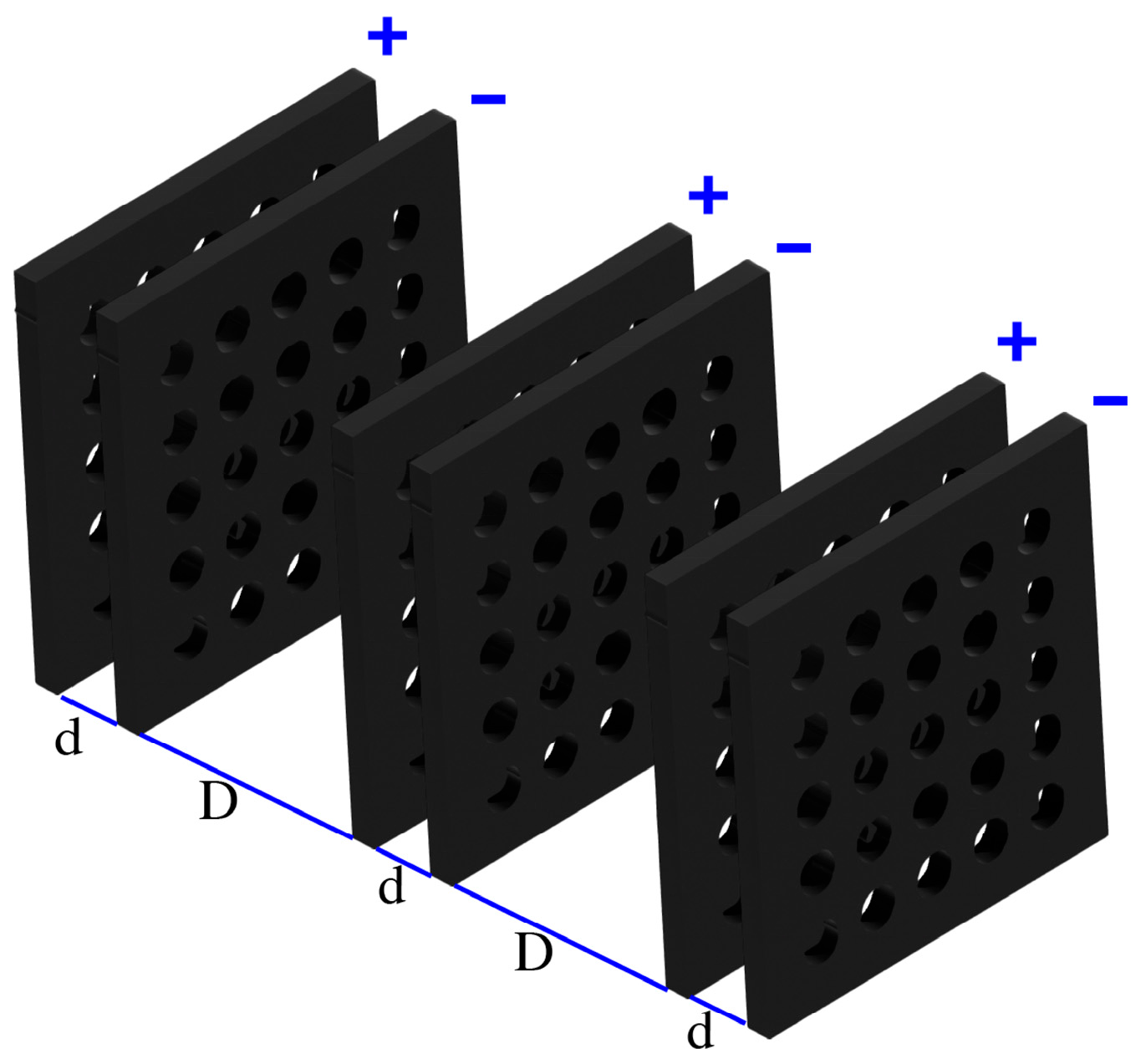
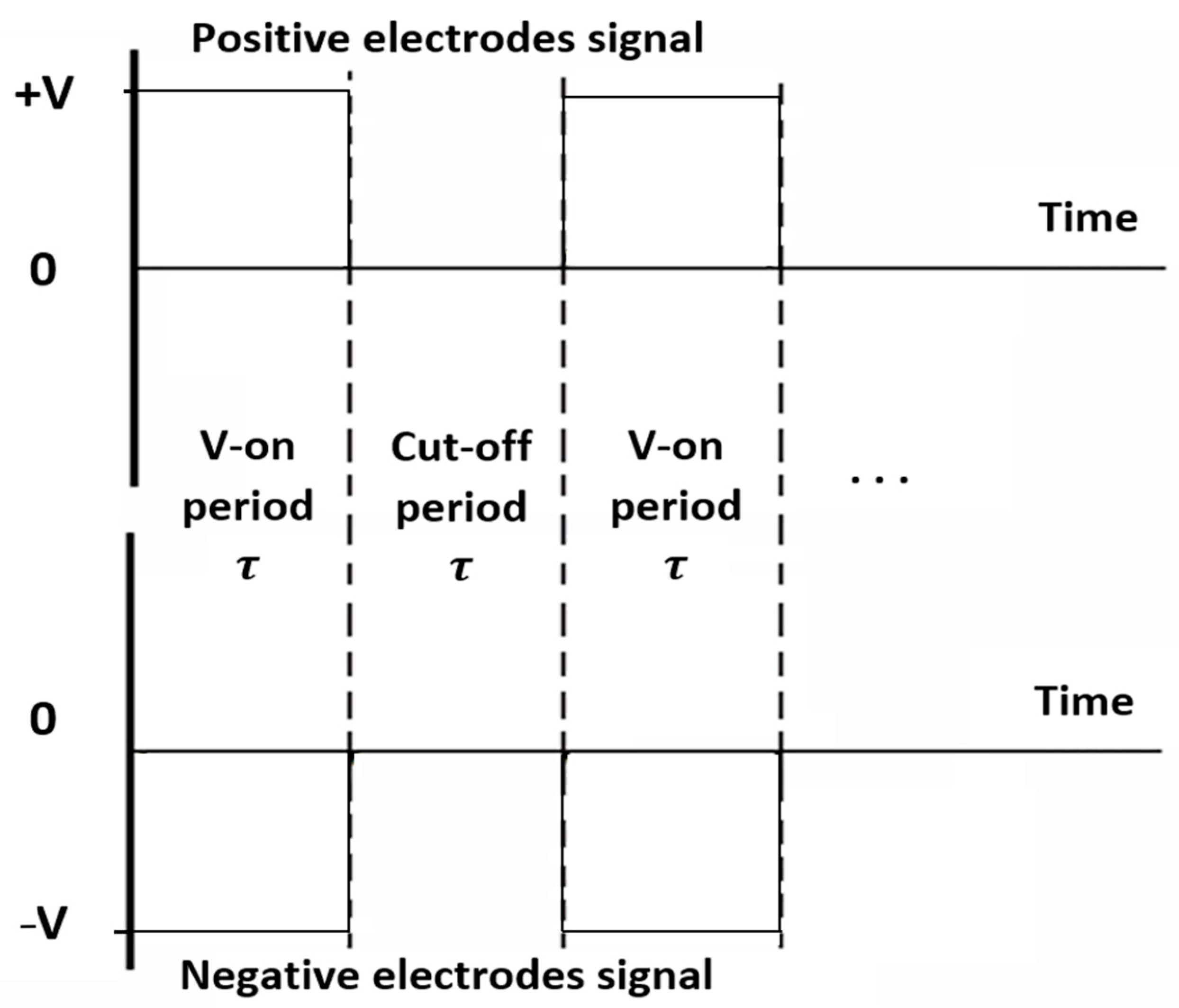

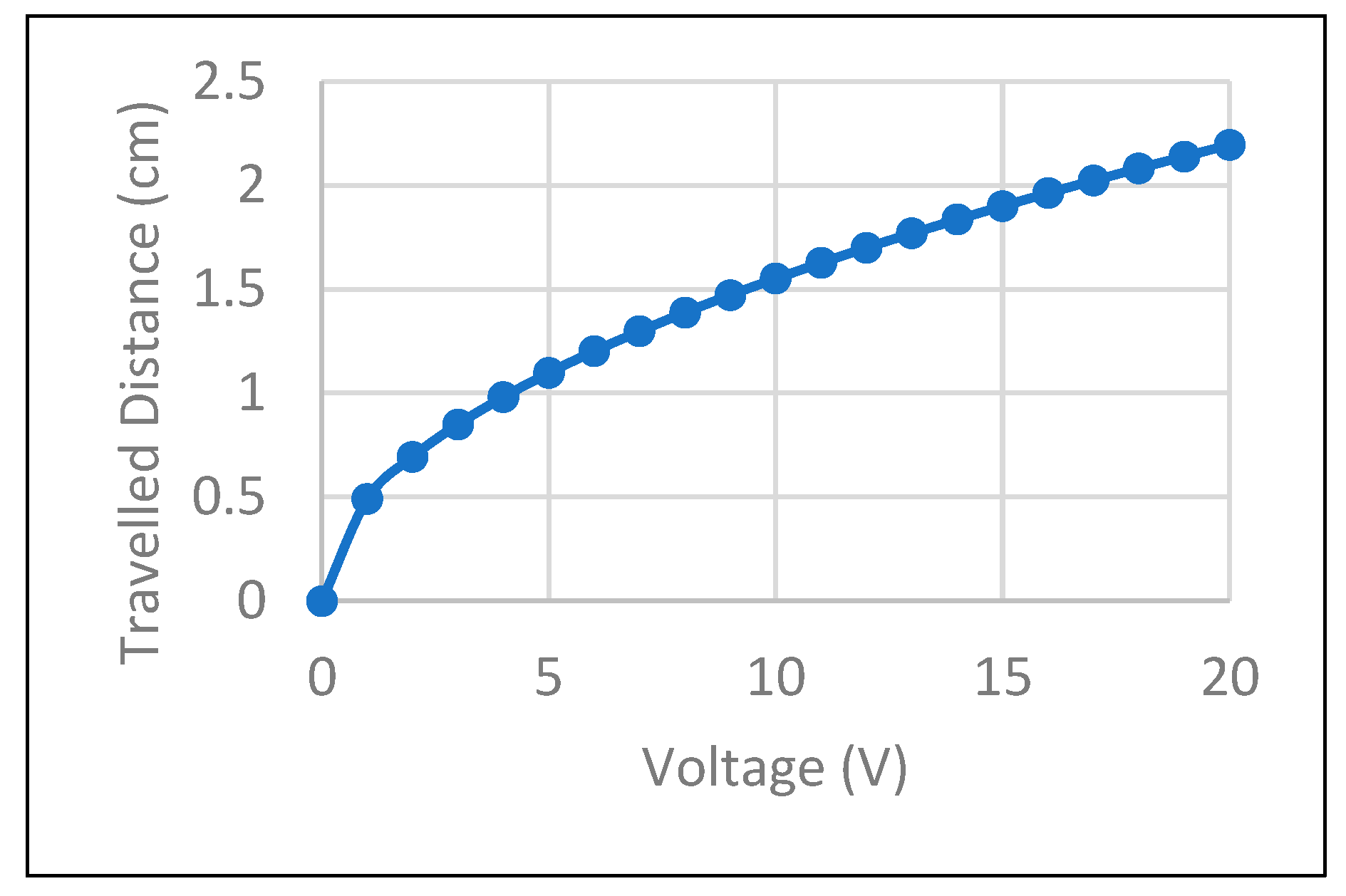
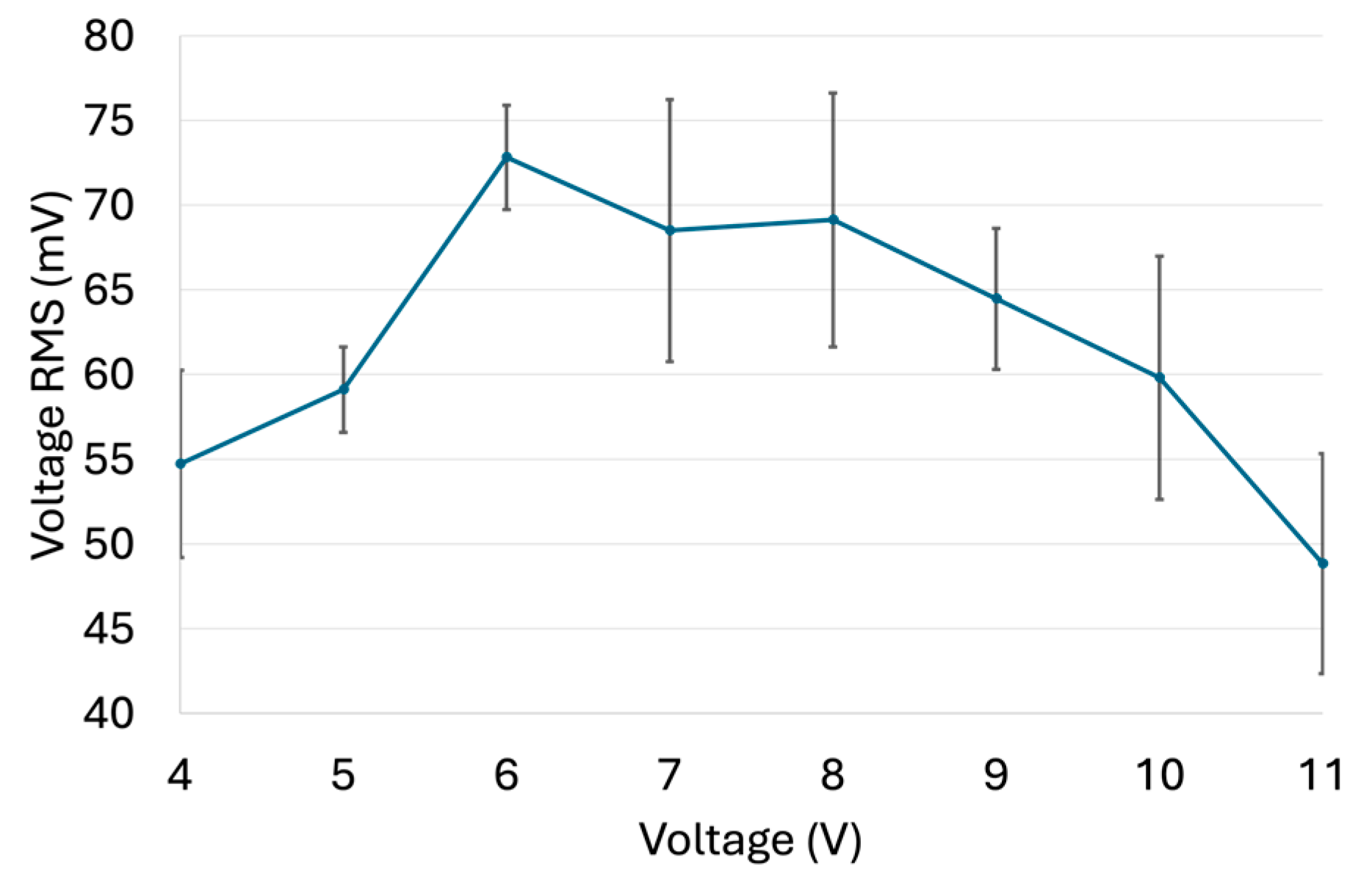


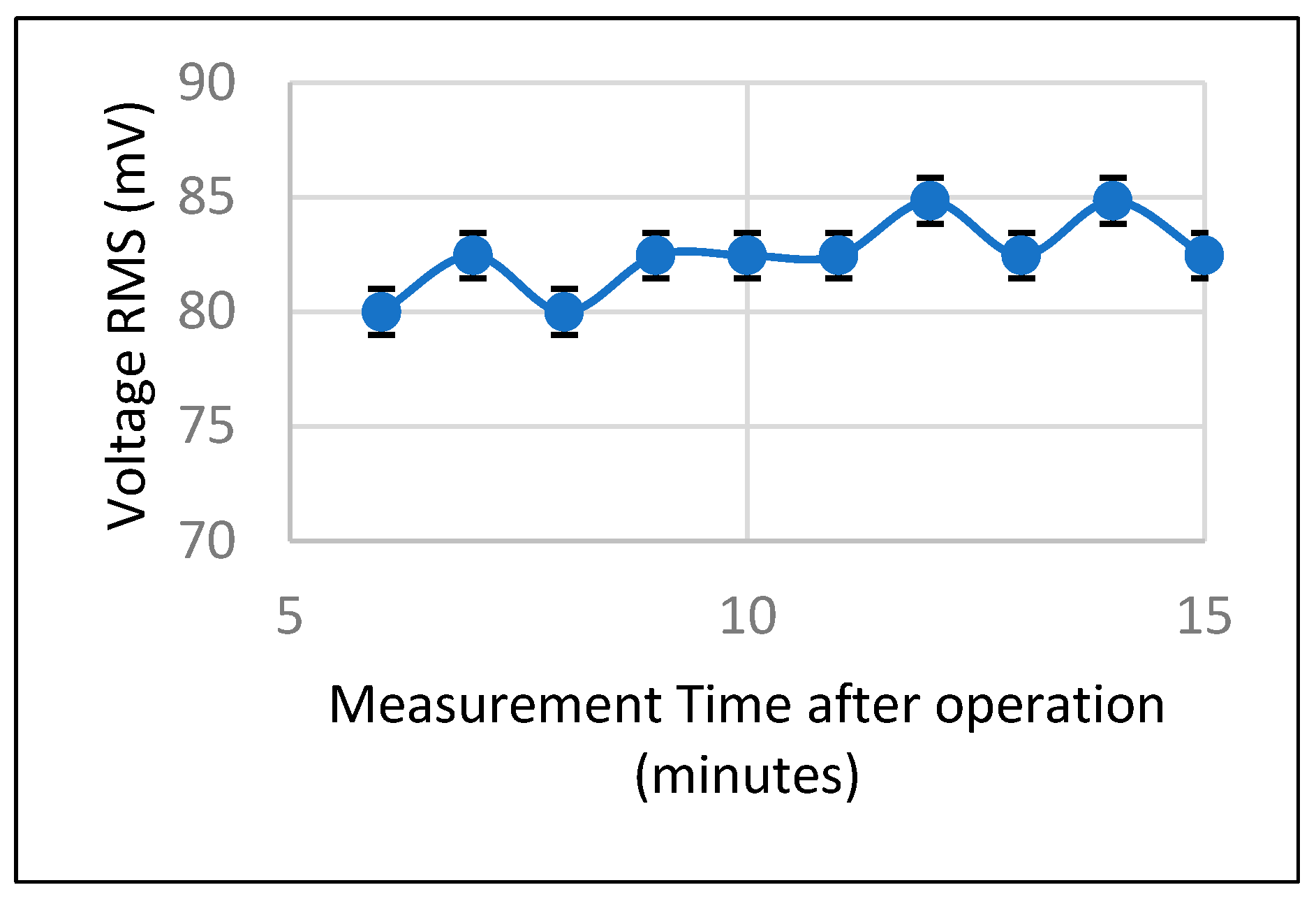
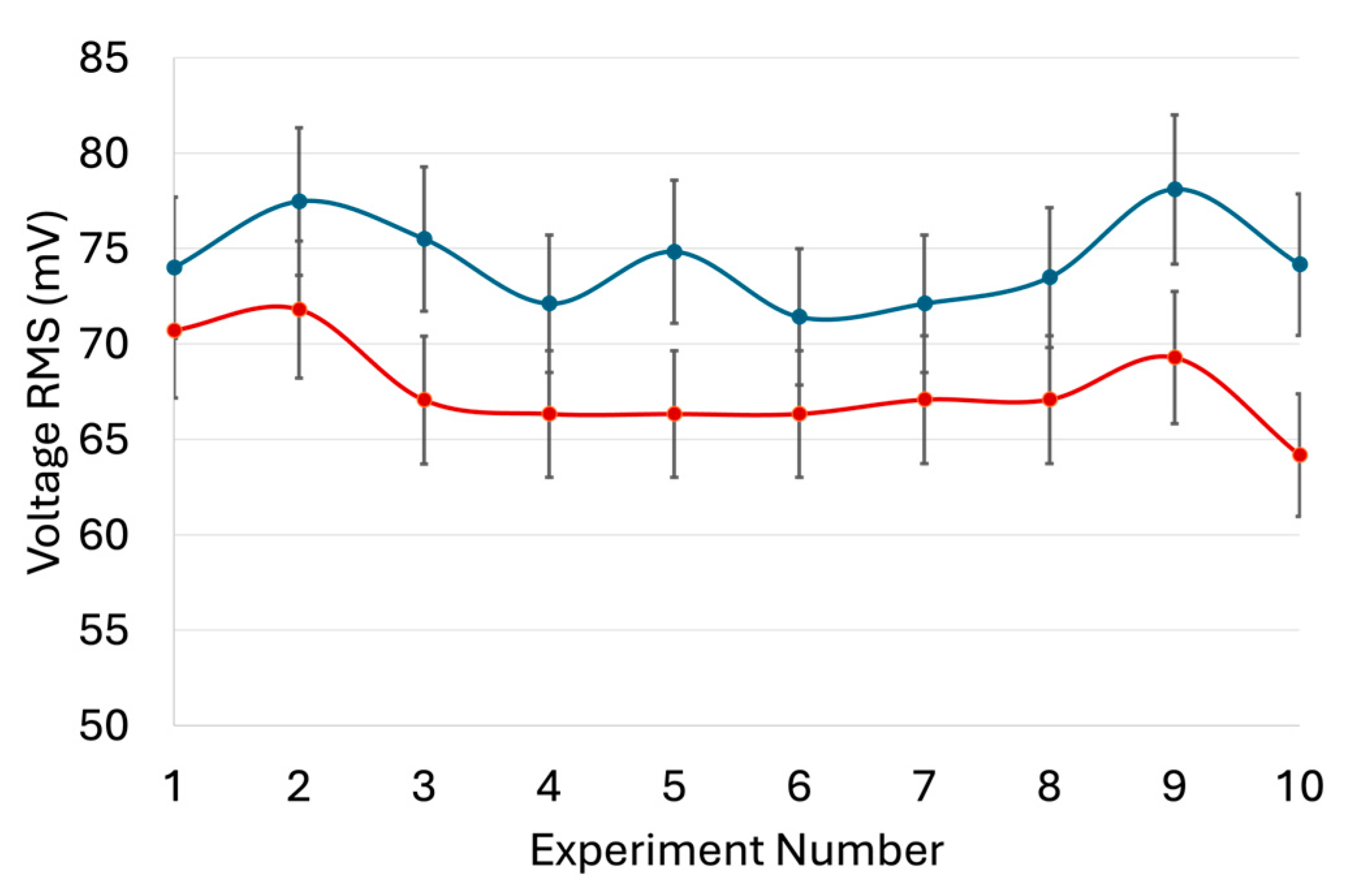

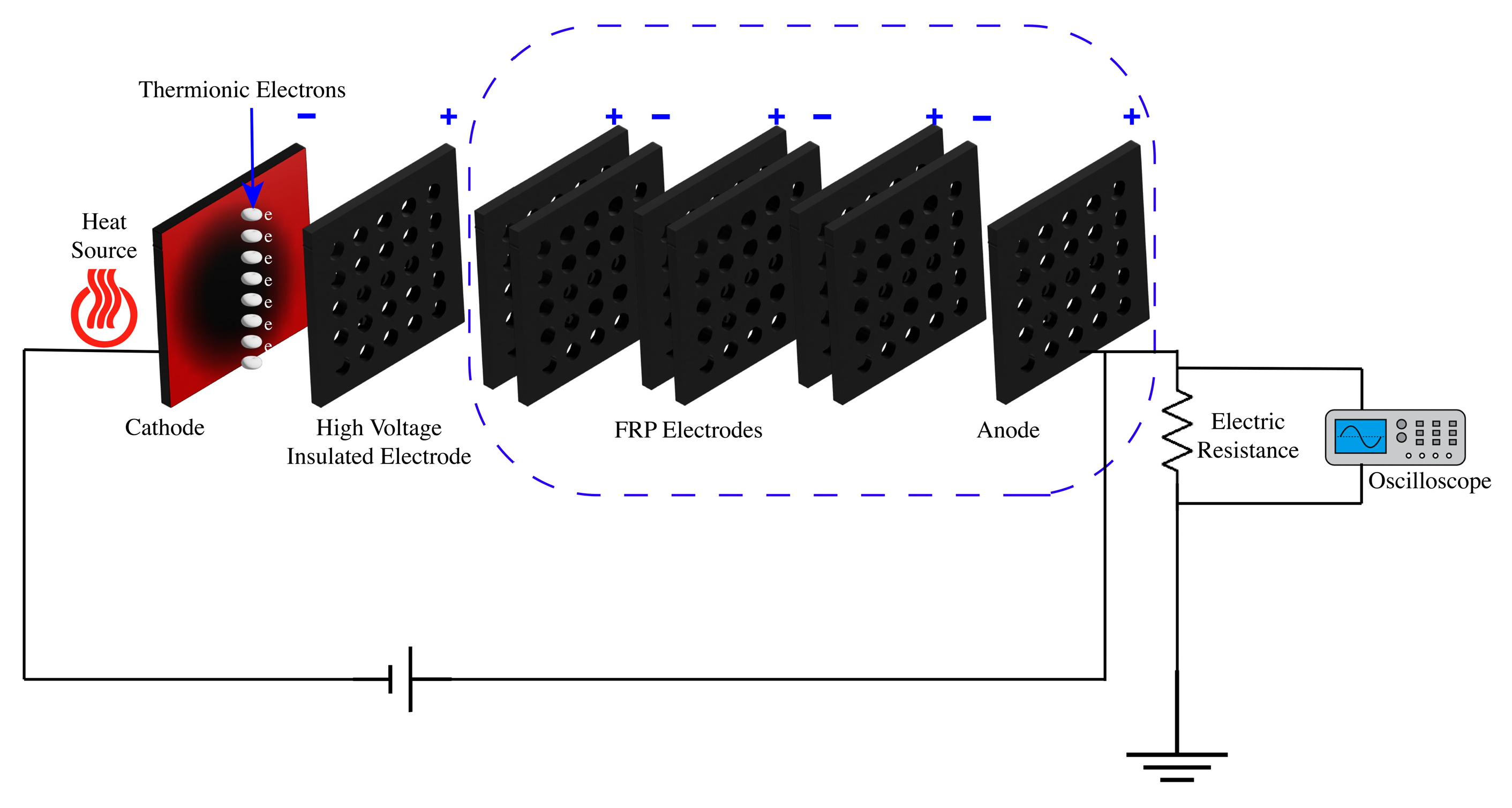

| Parameter | Symbol/Unit | Optimized Value | Observed Range | Notes |
|---|---|---|---|---|
| FRP voltage | V (V) | 6 V | 4–11 V | Optimal for stable ion transport |
| Frequency | f (kHz) | 600 kHz | 500–1000 kHz | Matches predicted O2−• travel distance (≈1 cm) |
| RMS voltage variation | ΔVRMS (mV) | 1.53 mV (≈2%) | — | From 10-cycle stability test |
| Transport efficiency | η (%) | ≈93% | — | Estimated from charge-arrival ratio at anode |
| Measurement stability | σ (%) | ≈2% | — | Ten-minute repeatability test |
Disclaimer/Publisher’s Note: The statements, opinions and data contained in all publications are solely those of the individual author(s) and contributor(s) and not of MDPI and/or the editor(s). MDPI and/or the editor(s) disclaim responsibility for any injury to people or property resulting from any ideas, methods, instructions or products referred to in the content. |
© 2025 by the authors. Licensee MDPI, Basel, Switzerland. This article is an open access article distributed under the terms and conditions of the Creative Commons Attribution (CC BY) license (https://creativecommons.org/licenses/by/4.0/).
Share and Cite
Al-Zain, Y.; Bqoor, M.; Albqoor, M.; Ismail, L. Next-Generation Airborne Pathogen Detection: Flashing Ratchet Potential in Action. Chemosensors 2025, 13, 371. https://doi.org/10.3390/chemosensors13100371
Al-Zain Y, Bqoor M, Albqoor M, Ismail L. Next-Generation Airborne Pathogen Detection: Flashing Ratchet Potential in Action. Chemosensors. 2025; 13(10):371. https://doi.org/10.3390/chemosensors13100371
Chicago/Turabian StyleAl-Zain, Yazan, Mohammad Bqoor, Maha Albqoor, and Lujain Ismail. 2025. "Next-Generation Airborne Pathogen Detection: Flashing Ratchet Potential in Action" Chemosensors 13, no. 10: 371. https://doi.org/10.3390/chemosensors13100371
APA StyleAl-Zain, Y., Bqoor, M., Albqoor, M., & Ismail, L. (2025). Next-Generation Airborne Pathogen Detection: Flashing Ratchet Potential in Action. Chemosensors, 13(10), 371. https://doi.org/10.3390/chemosensors13100371







